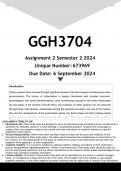GGH3704
Assignment 2 Semester 2 2024
Unique Number: 673969
Due Date: 6 September 2024
Introduction
Urban systems have evolved through significant phases that have shaped contemporary urban
environments. The history of urbanization is deeply intertwined with broader economic,
technological, and social transformations, each contributing uniquely to the urban landscapes
we see today. In the context of South Africa, the evolution of urban systems can be observed
through three main phases: urbanization during the industrial revolution, the rise of the modern
city, and the development of the postmodern-global city. Each phase has left a lasting impact
on the structure, function, and dynamics of urban areas. This essay will discuss the evolution
DISCLAIMER & TERMS OF USE
1. Educational Aid: These study notes are designed to serve as educational aids and should not be considered as a
substitute for individual research, critical thinking, or professional guidance. Students are encouraged to
conduct their own extensive research and consult with their instructors or academic advisors for specific
assignment requirements.
2. Personal Responsibility: While every effort has been made to ensure the accuracy and reliability of the
information provided in these study notes, the seller cannot guarantee the completeness or correctness of all
the content. It is the responsibility of the buyer to verify the accuracy of the information and use their own
judgment when applying it to their assignments.
3. Academic Integrity: It is crucial for students to uphold academic integrity and adhere to their institution's
policies and guidelines regarding plagiarism, citation, and referencing. These study notes should be used as a
tool for learning and inspiration, but any direct reproduction of the content without proper acknowledgment and
citation may constitute academic misconduct.
4. Limited Liability: The seller of these study notes shall not be held liable for any direct or indirect damages,
losses, or consequences arising from the use of the notes. This includes, but is not limited to, poor grades,
academic penalties, or any other negative outcomes resulting from the application or misuse of the information
prov
]
, For additional support +27 81 278 3372
Introduction
Urban systems have evolved through significant phases that have shaped contemporary
urban environments. The history of urbanization is deeply intertwined with broader
economic, technological, and social transformations, each contributing uniquely to the urban
landscapes we see today. In the context of South Africa, the evolution of urban systems can
be observed through three main phases: urbanization during the industrial revolution, the
rise of the modern city, and the development of the postmodern-global city. Each phase has
left a lasting impact on the structure, function, and dynamics of urban areas. This essay will
discuss the evolution and impact of these phases, providing relevant South African
examples to illustrate their influence on contemporary urban environments.
Urbanization During the Industrial Revolution
The industrial revolution, beginning in the mid-1700s, marked a significant turning point in
the history of urbanization. It was a period characterized by rapid technological
advancements, including the development of power plants, the steam engine, and the
mechanization of industry. These innovations necessitated the creation of physical
infrastructure, such as factories, warehouses, and transport networks, which in turn
stimulated the growth of cities.
In South Africa, the impact of the industrial revolution on urbanization became evident during
the late 19th and early 20th centuries. The discovery of minerals, particularly gold and
diamonds, in regions such as Kimberley and the Witwatersrand, catalyzed urban growth.
Cities like Johannesburg emerged as economic hubs, driven by mining activities and the
need for labor. The Central Business Districts (CBDs) of these cities became the focal points
of economic activity, with high-density cores surrounded by lower-density zones of
transition.
This period also witnessed the development of world cities, where economic power was
concentrated in specific urban areas. Johannesburg, for instance, became a world city within
the context of the global mining economy. The division of labor, both locally and
internationally, was evident in the way labor was sourced and utilized in these industrial
cities. The demographic transition that accompanied this period led to significant population
growth in urban areas, fueled by migration from rural regions and abroad.




